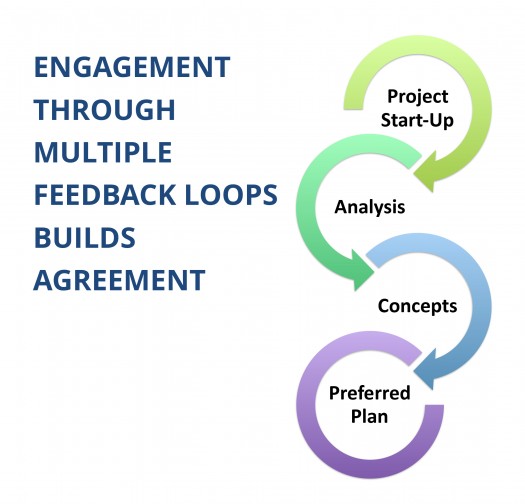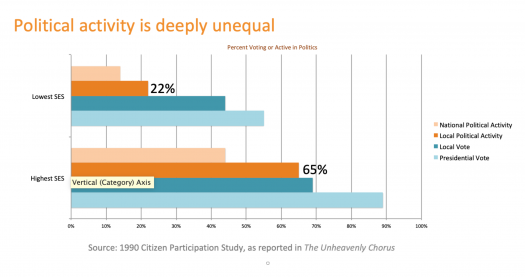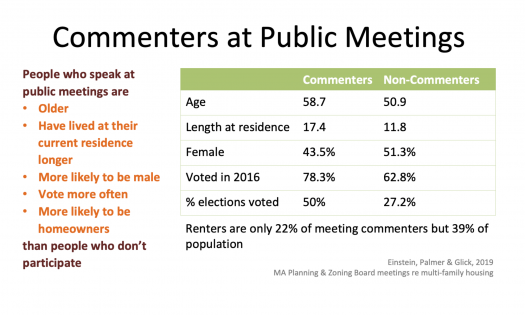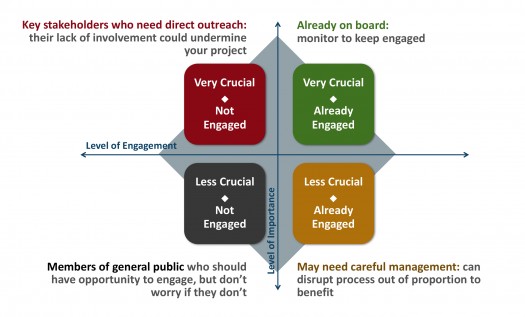A Placemaking Journal
Public Participation, Part II: Equitable Outreach
This is Part II of a two-parter on community engagement strategies in a new era. Part I is here. This conversation is the third in our series addressing planning challenges for local governments in a post-pandemic future. The two previous topics can be found here and here.
Jennifer Hurley is President & CEO of Hurley-Franks & Associates, a planning consultancy firm, and a PhD candidate in Human and Organizational Development at Fielding Graduate University. She’s a current or past board member of a number of professional organizations, including The Congress for the New Urbanism, the National Charrette Institute, and the Form-Based Codes Steering Committee.
Ben Brown: In Part I of this conversation, we left off with your point that it’s nearly impossible, even in ideal situations, to fix gaps in outreach by simply having more meetings.
Jennifer Hurley: Right. We know, both from our own ad hoc experience, and also from statistical research, that the people who speak at public meetings do not represent everyone. For local political activity, like the kind of public meetings we hold for planning projects, only 22% of people in the lowest quintile of socioeconomic status participate, while 65% of people in the highest quintile participate.
JH: People who speak up and make comments at public meetings are older, have lived at their current residence longer, are more likely to be male, vote more often, and are more likely to be homeowners than people who do not comment.
BB: And then in times like these, with in-person meeting restrictions because of the pandemic, the usual barriers become higher. The default answer is to move everything online. What complicates that approach?
JH: The first question, I think, is who gets left out? Typical government meetings leave out most people who aren’t the “civically obsessed” “frequent fliers” — young people, people with children or other evening obligations, people with mobility challenges, people who work multiple jobs, people who are poor, people who are very old, people who do not speak English, people who have vision or hearing limitations — anyone who has limited time, limited mobility, or limited access to information about when the meetings happen.
BB: And when we try to take everything online?
JH: Online tools leave out some of the same people and also some other people. They leave out people without access to or comfort with broadband — people who are poor, people who are very old, people who do not speak English, people who have reading limitations, people who have vision limitations. If we have to rely on online materials and mailers, we have to think about the nine percent of US residents over the age of five who have limited English proficiency; the 19 percent of US adults whose reading ability is too low to read a newspaper; and the 4.5 percent of the US population who are colorblind and likely to struggle to interpret charts and other graphics. More people have access to a smartphone than a computer, but they may have significant data download/upload limits. Text-based tools are more broadly accessible, but they still require English reading ability.
BB: So where does that leave us?
JH: We just have to be more attentive to how we use the online tools. If you look at everyone the conventional in-person meetings leave out compared to who gets left out with online tools, I think the online tools actually give more access to more people. The difference is that when we have enough time and money, we can use community organizing techniques to expand in-person outreach with small group and one-on-one meetings to connect with people who are typically under-represented, but it’s much harder to find ways to overcome some of the access barriers for online tools.
BB: Those would seem formidable enough issues to resolve. But you’ve also been thinking about some limitations of online engagement, even for those who are already comfortable with computers and the internet.
JF: Consider time. Everyone is used to thinking about digital tools as fast, including the speed of misinformation and of protestors organizing opposition action. But I also think we need to start thinking about digital engagement as slow. It takes more time to build trust in a digital environment than in person. It takes time to build an audience for digital tools (websites, online surveys, etc). It takes more rounds of feedback, because some aspects of communication are harder when you have “thin” versus “thick” communication and when there are so many opportunities for miscommunication.
BB: Explain “thin” vs. “thick.”
JH: Some communication channels are “thick” because you are getting information in multiple ways. Think about the differences between talking to someone in person, versus on the phone, versus reading an email. When you talk to someone in person, you have their words, but you also get information about their meaning from their tone of voice and their body language. Over the phone, you’re missing the body language but still get the tone of voice. And when you get down to email, all you have are the words themselves. That’s one of the reasons social media discussions can go sideways so easily.
BB: So what should we be thinking about when we go online?
JH: Everything online has to be able to stand on its own. When I’m standing next to a presentation board at a public meeting, I can explain things that are confusing. But online, people have to be able to understand it themselves without a person explaining it to them. What does this mean for language and graphics? It means we have to work much harder at that piece. Most of us who are planners and architects and engineers grew up loving maps and drawings, but that makes us a little weird, and it means that we don’t always see how hard it is for other people to interpret our graphics.
BB: Are there any built-in advantages with the technology?
JH: Online environments can broadcast information well, and they can also collect information fairly well, at least for concrete questions. But except for like-minded social/professional groups or communities of practice, I still haven’t seen online environments support back-and-forth interaction very well.
BB: So where does that leave us, especially given the restrictions on most group meetings during this phase of the pandemic?
JH: Well, we have to use the online tools. It’s required now because of COVID. But that’s just pushing us to make a transition that’s needed anyway for all of the access reasons we talked about. The key is not which shiny gizmo we use, but how we use them. I think this means that our long-time focus on key stakeholder engagement using community organizing tactics is more important than ever.
BB: Outline that approach for us.
JH: It gets back to our question of who our stakeholders are, who’s likely to be missing, and how to reach them. I have another group activity I like to do with project teams when we’re doing the engagement planning: We brainstorm all of the stakeholders we can think of who might be affected by a project or who may influence the outcome of a project. Everyone we can think of goes on a sticky note so we can put them on the wall and move them around, and then we think about: First, how crucial is this stakeholder for this particular project; then how engaged are they already? We end up with four quadrants that tell us something about how we need to engage with different categories of stakeholders.
BB: Walk us through the quadrants.
JH: The group that is most crucial is the “very crucial, not engaged” group. These are the people who will add the broad diversity of opinion we’re looking for, but they generally won’t show up with the run-of-the-mill meeting announcement. We have to reach out to these people directly, connecting with them through people they already know and trust. That stakeholder engagement approach works for in-person meetings, and it also works for online engagement. The “very crucial, already engaged people” are likely to be engaged without direct outreach, but if they start to disappear during the process, you want to find out if they are dropping out because they trust the process and no longer feel a need to be a watchdog, or if they have dropped out because they are mad about something (or maybe the engagement process is just too boring). The “less crucial, already engaged” people are often single-issue advocates who come to every meeting to talk about the same thing. They can add very important detail and nuance to a particular topic, but if there are not enough “very crucial, not engaged” people brought into the process, then the “less crucial, already engaged” people can really sway the process in an unfair way. The “less crucial, not engaged” people make up the broad general public—most of them don’t have time to participate in planning processes, but it’s important that we run our processes in an open, transparent way, so that if people decide they want to participate, it’s easy for them to find out how.
BB: When we can rely on in-person engagement strategies, we usually plan for large group meetings to provide feedback for works in progress. It gives us a chance to demonstrate in real time that we’re listening and responding to what people say. There’s a big advantage in spotting friction points and addressing them in person. But we lose that advantage when we lose the option of large in-person meetings.
JH: Yes, the piece that is really different online is the interactive piece. When we’re limited to working online, we can’t rely on one big meeting. We have to use more small-number engagements. You can get some good interaction on a video call with eight people, but not much on a webinar with 100 people. So if you really need interaction and discussion, instead of one 100-person meeting, you need ten 10-person meetings. And because we can’t get the same kind of mixing across stakeholder groups in those smaller separate meetings that we can get in the one larger meeting, you probably need to add more feedback loops into your planning process, where you listen, and then feed back what you heard, and then listen again.

JH: This is a scary time for a lot of people. And it’s stressful to have all of our usual ways of working upended overnight. But for planners, we have a real opportunity to change how we work in a way that will be more effective and more equitable.
–Ben Brown
If PlaceShakers is our soapbox, our Facebook page is where we step down, grab a drink and enjoy a little conversation. Looking for a heads-up on the latest community-building news and perspective from around the web? Click through and “Like” us and we’ll keep you in the loop.










